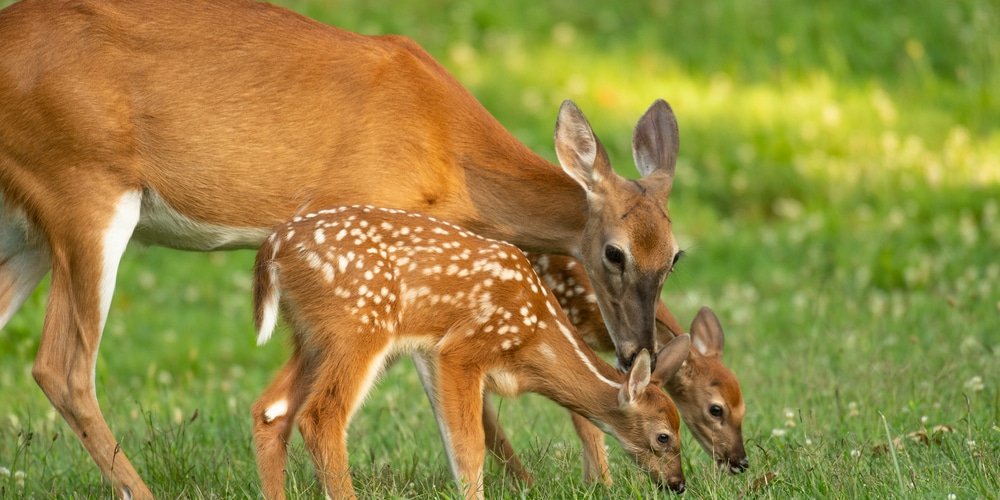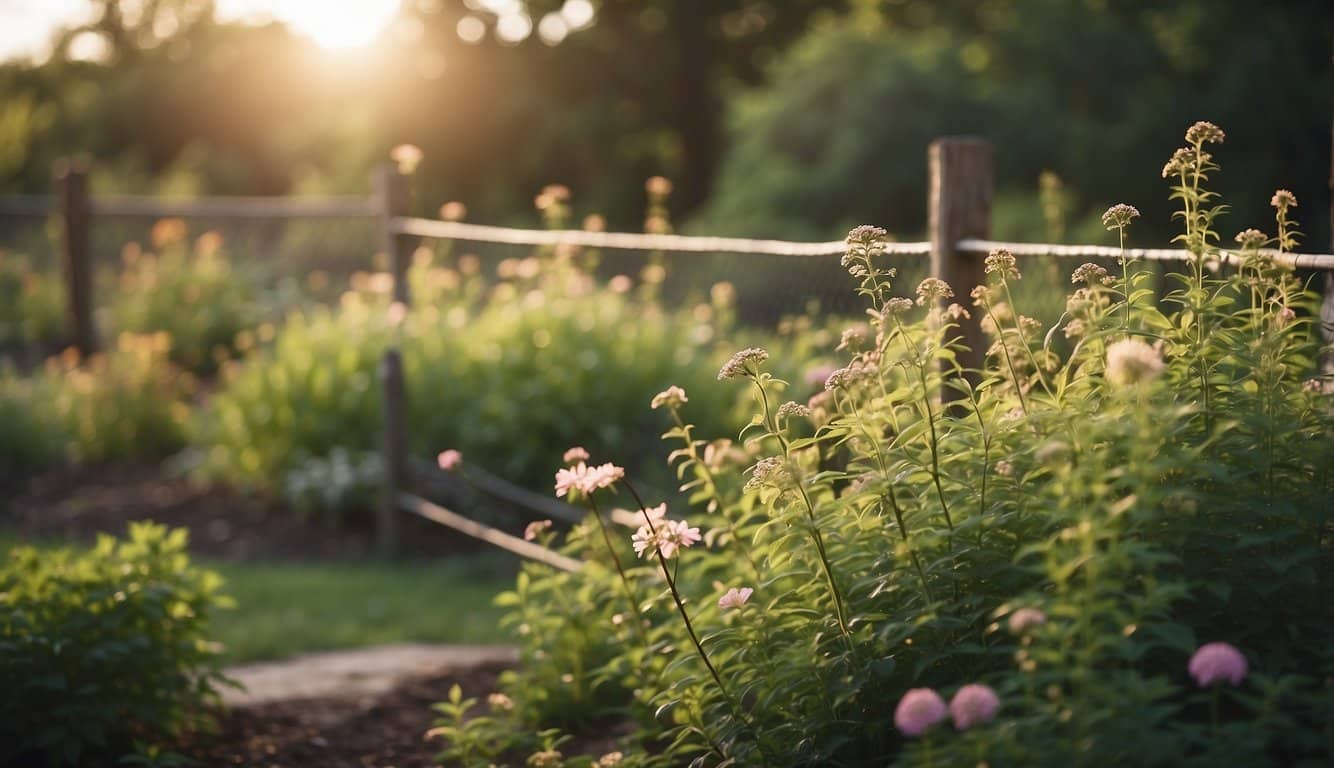Illinois is full of wildlife. The good news is there’s a lot you can do to create a passive defense perimeter for your garden. Let’s get to it!
Common Illinois Local Wildlife
To effectively safeguard your garden in Illinois, gaining a grasp of the wildlife that frequents the area is essential.
Illinois is home to a colorful array of creatures, each with its unique behaviors and eating habits.
Common Garden Visitors:
- Deer: Grazers who enjoy nibbling on a variety of plants.
- Rabbits: Known for their love of greens like lettuce and carrots.
- Squirrels: May dig up bulbs or munch on fruits and nuts.
- Raccoons: Omnivorous with a knack for mischief in search of food.
Animal Diets & Habits:
- Deer and rabbits tend to favor fresh shoots and vegetables.
- Squirrels are attracted to areas with abundant nuts and seeds.
- Raccoons are night foragers, often hunting for anything they can find.
Detection & Monitoring:
- Inspect your garden regularly for signs of disturbance.
- Use motion-sensitive cameras to identify nocturnal activities.
Habitat Knowledge:
Understanding the environments that these animals thrive in can assist you in making your garden less enticing.
| Wildlife | Preferred Habitat |
|---|---|
| Deer | Woodland edges |
| Rabbits | Brushy areas |
| Squirrels | Trees with dense canopies |
| Raccoons | Wooded areas near water |
Designing a Garden Layout with Defense in Mind
To protect your Illinois garden from foraging wildlife, careful planning and strategic plant selection are paramount.
Choosing Resistant Plants
Selecting plants that are less appealing to wildlife is a key strategy.
A table below lists common Illinois garden plants and their resistance to wildlife:

| Resistant Plants | Wildlife Generally Avoids |
|---|---|
| Boxwood (Buxus) | Deer, Rabbits |
| Marigolds (Tagetes) | Deer |
| Russian Sage (Perovskia) | Deer, Rabbits |
| Lavender (Lavandula) | Deer, Rabbits |
| Ornamental Grasses | Deer |
Incorporate these plants as a first line of defense.
Boldly feature them around the perimeter or interspersed throughout your garden as a deterrent.
Natural Barrier Implementation
When laying out your garden, integrating natural barriers effectively can deter wildlife.
Consider the following types of natural barriers:
- Hedges: Densely planted rows of prickly hedges such as Barberry (Berberis) can act as an effective physical deterrent.
- Rocks and Boulders: A strategic array of large rocks or boulders can block entry and restrict easy access to other garden delicacies.
- Water Features: A well-placed pond or stream can act as a barrier that some animals, like rabbits, may be reluctant to cross.
Position natural barriers strategically to obstruct common wildlife paths toward your garden without detracting from its aesthetic appeal.
Installing Protective Structures
Protecting your garden from wildlife involves implementing the right mix of physical barriers and deterrents. Here’s how you can reinforce your Illinois garden against unwelcome animal intruders.
Physical Barriers
Fencing: Your first line of defense is fencing.
A sturdy fence that is at least 8 feet tall can help deter deer.
For burrowing animals like rabbits and groundhogs, extend a mesh wire at least a foot underground.
| Animal | Fence Height | Burial Depth | Material |
|---|---|---|---|
| Deer | 8 feet | N/A | Wood/Metal Mesh |
| Rabbits | 2-3 feet | 1 foot | Metal Mesh |
| Groundhogs | 3-4 feet | 1 foot | Metal Mesh |
Netting: Apply bird netting over trees or shrubs that bear fruit to keep birds and squirrels at bay.
Make sure it’s secured to the ground to prevent animals from getting underneath.
Deterrents and Repellents
Chemical Repellents: Consider using chemical repellents around the perimeter of your garden.
These should be non-toxic and safe for use around plants. Always follow the manufacturer’s guidelines to ensure effectiveness and safety.
- Odor repellents deter by smell
- Taste repellents discourage by flavor
- Contact repellents keep animals away through an unpleasant sensation
Motion-activated Devices:
Installing motion-activated sprinklers can startle and scare away animals with a sudden spray of water.
Similarly, ultrasonic devices can emit frequencies that are uncomfortable for pests.
Strategically placed deterrents can provide an effective psychological barrier without physical constraints. Combine these with physical barriers for the best results.
Maintaining a Wildlife-Resistant Garden
Creating a wildlife-resistant garden requires vigilance and strategic planning to ensure your horticultural efforts are not compromised by local fauna.
Regular Monitoring
Regularly inspect your garden for signs of animal activity.
This includes looking for tracks, droppings, or plant damage.
Early detection is key to prevent extensive harm.
Keep a log in a notebook or digital document to track the frequency and types of wildlife encounters, as this information can be crucial for tailoring your defense strategies effectively.
Habitat Disruption Strategies
Implement habitat disruption methods to deter wildlife from making your garden their haven. This can involve:
- Physical Barriers: Construct fences that are tall and buried deep enough to discourage diggers like rabbits. Use mesh covers to protect seedlings.
- Repellents: Apply natural or chemical repellents to make your garden less appealing. Always follow the manufacturer’s instructions for safe and effective application.
- Garden Layout: Design your garden with wildlife resistance in mind.
- Place more vulnerable plants closer to the house or in raised beds, and intersperse them with plants known to be less attractive to animals.
Frequently Asked Questions
In navigating the challenges of protecting your Illinois garden from wildlife, you’ll find that natural deterrents, physical barriers, homemade remedies, and strategic plant choices can provide effective solutions without harming the ecosystem.
What are natural methods to deter animals from invading my Illinois garden?
You can deter animals naturally by removing attractants such as fallen fruit, utilizing garden arrangements that discourage wildlife access, and incorporating plants that animals find unappealing or that mask the scent of your crops.
What can be used to enclose a garden to prevent animal intrusion effectively?
For a robust barrier, consider installing a wire mesh fence buried at least a foot underground to thwart burrowing animals. Combine this with an angled outward top to prevent climbing species from gaining access to your garden.
What home remedies are effective as animal repellents for gardens?
Create a homemade repellent using ingredients like garlic, pepper, or vinegar in a spray solution. Apply it around the perimeter of your garden to create a scent barrier that many garden invaders dislike.
Which plants can act as a deterrent to protect my garden from wildlife?
Plants such as marigolds, lavender, and herbs like mint carry strong scents that can deter deer and rabbits. Intersperse these throughout your garden to take advantage of their repellent properties.
How can I safeguard my container garden from animal pests?
Elevate your container gardens onto stands or incorporate hanging planters to put your plants out of reach.
Additionally, sticky repellents can be applied to the containers themselves to dissuade climbers.
What are the most effective strategies for protecting a vegetable garden from wildlife without using a fence?
Utilize row covers for immediate plant protection. Implement raised beds to add an extra element of deterrence. Encourage natural predators by providing habitats for creatures like birds and beneficial insects which naturally manage pest populations.
Last update on 2025-04-16 / Affiliate links / Images from Amazon Product Advertising API




